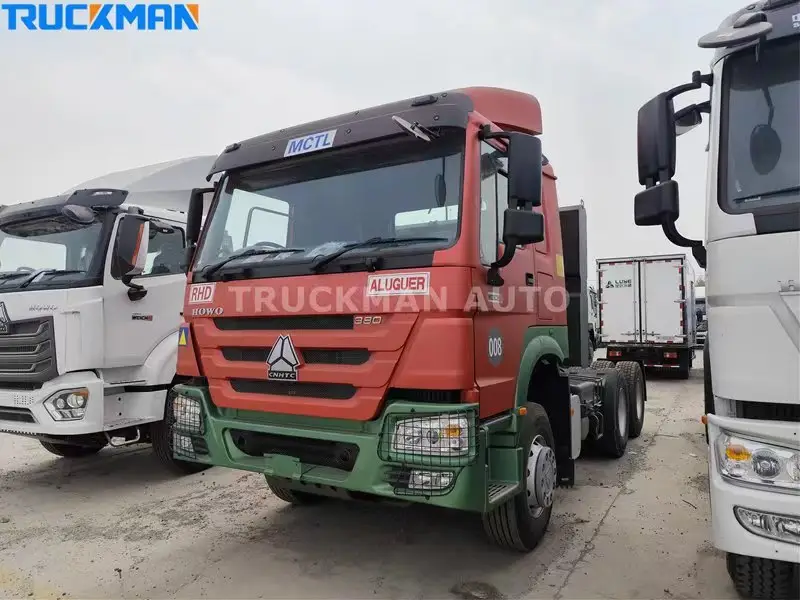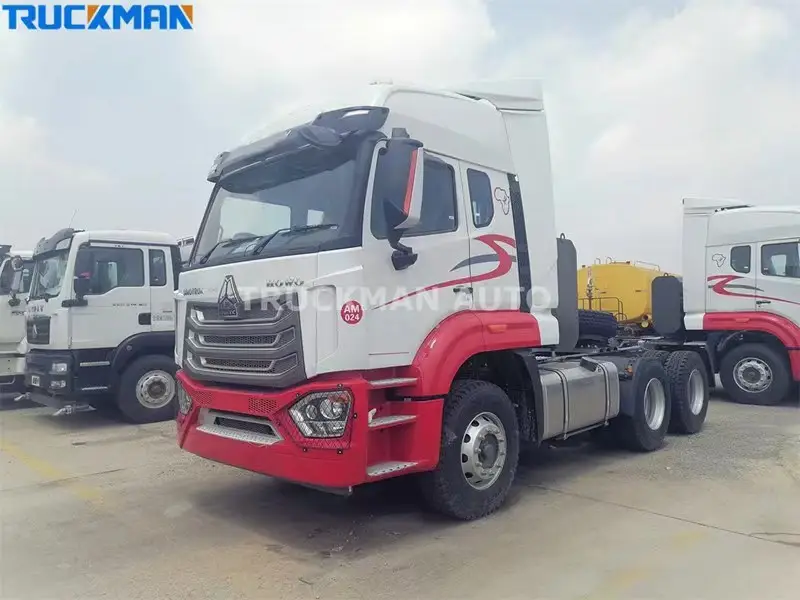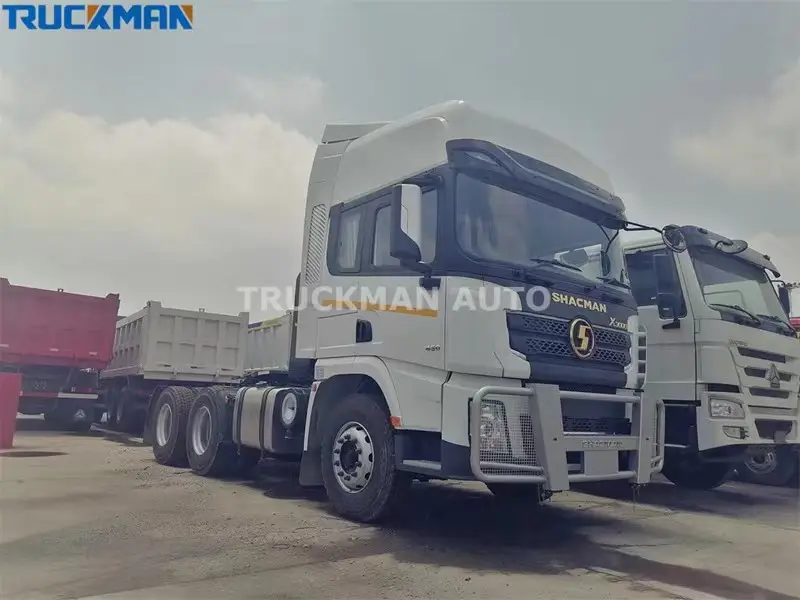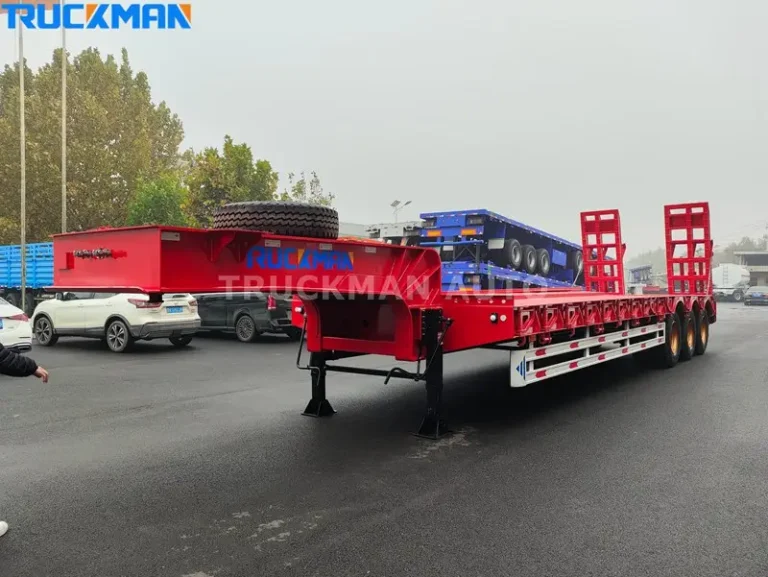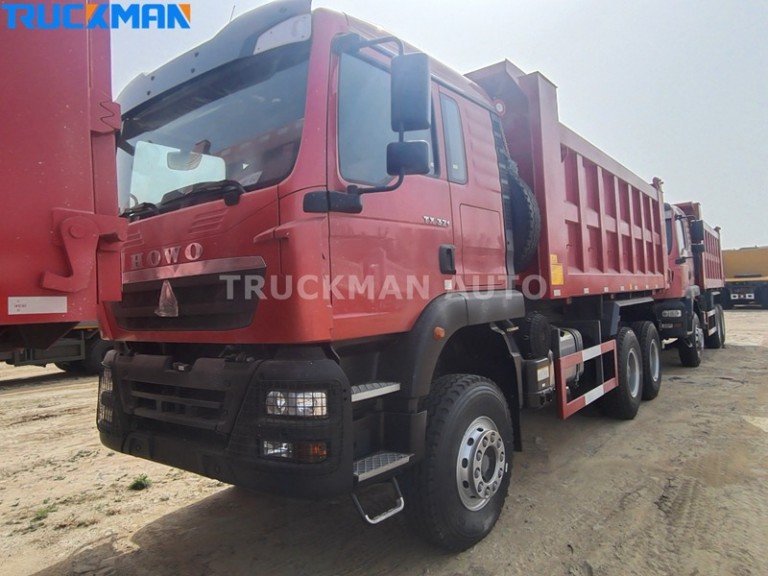Truckman Automobile, as a leading semi-trailer manufacturer, provides key insights for the transportation industry. The tractor trailer, also known as a semi-truck or 18-wheeler, is a combination vehicle consisting of a powerful tractor (with engine, cab, and control devices) and a separate, detachable semi-trailer for carrying cargo. The tractor is used to pull the trailer, and the entire unit is crucial for efficient long-distance transportation of goods throughout the supply chain. These powerful vehicles are the backbone of the freight industry, ensuring efficient delivery of goods worldwide.
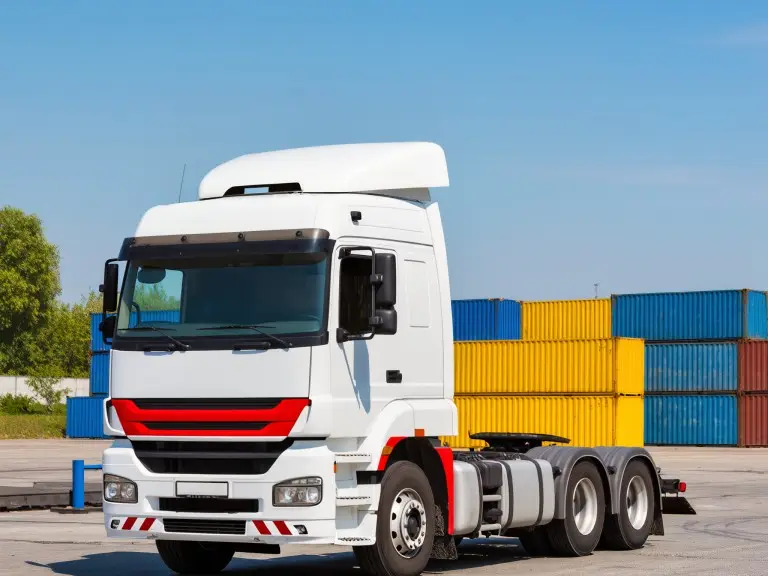
Table of Contents
Understanding Tractor Trailers
Tractor trailers play a key role in the global supply chain, and their importance cannot be underestimated. As a semi trailer manufacturer, Truckman Automobile is at the forefront of producing high-quality trailers to meet the evolving needs of the logistics industry.
A tractor trailer consists of two independent units: the power unit (tractor) and the cargo unit (trailer). The tractor (or power unit) is responsible for pulling the trailer, while the trailer is a large container for carrying goods. “Tractor trailer” and “semi-truck” are often used interchangeably, but there is a subtle difference. A semi-truck typically refers to the tractor without a trailer, while a tractor trailer refers to the combination of the tractor and trailer. This vehicle system is designed for long-distance heavy-load transportation, providing a flexible solution for various transportation needs.
Why is it called a “tractor trailer”: This term directly refers to the combination of two independent units: the power unit (tractor) and the cargo unit (trailer).
How it works: The driver operates the tractor, pulling the trailer attached to it. Since the tractor and trailer are separate, one tractor can pull multiple different trailers, or the trailer can be parked on the tractor and detached. This separation design enhances operational flexibility, facilitating quick trailer changes or maintenance.
Understanding the basics of tractor trailers is crucial for selecting the right equipment. By clarifying industry terminology and concepts, we can better appreciate the role these vehicles play in the transportation ecosystem.
Key Components of Tractor Trailers
The functionality of a tractor trailer mainly relies on its tractor unit, which is the power and control center. The tractor unit, also known as a semi-truck, is the front part of the vehicle, containing the engine and cab.
Tractor Unit: Power and Control
The tractor unit is the front part of the vehicle, providing power. It houses the engine, cab, and components needed to operate the entire unit, delivering the power required for the truck to move. Modern tractor units are equipped with advanced engine specifications, including various horsepower and torque capabilities, aimed at optimizing fuel efficiency.
Cab design is another key aspect, focusing on cab layout and control systems. These elements significantly enhance operational efficiency and driver comfort. Advanced technology systems are integrated into the tractor unit, including engine management systems, transmission controls, and braking systems.
From a manufacturer’s perspective, the design of the tractor unit directly impacts the overall performance and capabilities of the tractor trailer. A well-designed tractor unit ensures the truck operates efficiently, safely, and effectively.
Semi-Trailer: Cargo Carrying Component
The semi-trailer is a key component of the tractor trailer, serving as the primary cargo-carrying unit. It is the unpowered rear part used for carrying goods. The semi-trailer is designed without a front axle, unable to stand independently, and relies on the tractor (or semi-truck) for support and mobility. It connects to the tractor via a fifth-wheel coupler and is designed to support its own weight with wheels.
The rear end of the semi-trailer rests on wheels, while the front is elevated and connected to the semi-truck. This configuration allows a significant portion of the semi-trailer’s weight to be supported by the semi-truck. The absence of a front axle is not a design flaw but a strategic choice that facilitates loading, unloading, and transporting goods, improving flexibility and efficiency.
The structural elements of the semi-trailer, including the frame, floor, walls, and roof systems, are designed to ensure cargo security and protection.
From a manufacturing perspective, designing semi-trailers involves careful consideration of engineering factors to achieve optimal load capacity, durability, and compatibility with various tractor units. Truckman Automobile prioritizes these aspects to produce high-quality semi-trailers that meet diverse customer needs.
The design of semi-trailers allows for various configurations to accommodate different cargo types. Whether it’s dry goods, refrigerated items, or oversized cargo, the semi-trailer’s design can be customized, making it a versatile part of the tractor trailer.
Anatomy of Tractor Trailers
At the core of every semi-truck is a robust engine designed to handle long-haul transportation demands. This engine is the heart of the vehicle, providing the power needed to move heavy loads.
Engine Technology
Engines used in tractor trailers are typically diesel-powered, chosen for their durability and high torque production. This is crucial for pulling heavy trailers up steep slopes and maintaining constant speeds on highways.
Modern truck diesel engines feature various displacement ranges, cylinder configurations, and power output specifications. These variations allow manufacturers to tailor engine performance to different application needs, from transporting heavy construction equipment to consumer goods.
Key Engine Components
Tractor trailer engine performance is influenced by several key components, including the cooling system, intake system, and exhaust system. The cooling system prevents overheating, ensuring the engine operates within a safe temperature range. The intake system provides sufficient clean air, which is essential for efficient combustion. The exhaust system manages gases produced during combustion, reducing emissions and noise.
| Component | Function | Importance |
|---|---|---|
| Cooling System | Prevents overheating | High |
| Intake System | Provides clean air for combustion | High |
| Exhaust System | Manages exhaust gases | High |
Powertrain Systems
The powertrain of a tractor trailer includes not only the engine but also the transmission and other components that work together to deliver power to the wheels. The transmission system is crucial, as it affects the truck’s performance, fuel efficiency, and overall operational costs.
Several types of transmission systems are used in modern tractor trailers, including manual, automated manual, and fully automatic transmissions. Each type has its advantages and is suited to different driving conditions and driver preferences.
From an engineering perspective, the integration of powertrain components is crucial for achieving optimal performance, reliability, and cost-effectiveness in commercial applications. By carefully designing and matching engine and transmission systems, manufacturers ensure trucks can handle long-haul transportation demands while minimizing operational expenses.
Cab Design
The design of a tractor trailer’s cab is crucial for ensuring driver comfort, safety, and productivity. As the vehicle’s control center, drivers spend a significant amount of time on the road.
Tractor trailers can be broadly categorized into two types based on cab design: day cabs and sleeper cabs. Day cabs lack sleeping berths and are typically used for shorter routes where drivers return home at the end of their shift. In contrast, sleeper cabs are equipped with sleeping compartments, designed for long-haul trucking where drivers may spend several days on the road.
The choice between a day cab and a sleeper cab depends on business operational needs. For example, logistics companies requiring drivers to be on the road for extended periods prefer sleeper cabs, while those with shorter routes opt for day cabs.
Ergonomics play a vital role in cab design, focusing on driver comfort and reducing fatigue. Key considerations include seat positioning, control layout, and visibility features. Modern cabs are designed to minimize driver strain, with adjustable seats and controls that can be tailored to individual driver preferences.
Noise reduction technologies are also part of cab design, creating a quieter environment that helps reduce driver fatigue during long hauls.
Sleeper cabs offer a range of living accommodations, from basic to premium configurations. Basic sleeper cabs include a single bed and some storage, while premium models may include two beds, a mini-fridge, microwave, TV, and surround sound systems. These amenities are designed to make life on the road more comfortable for drivers who spend extended periods in their trucks.
Types of Semi-Trailers Manufactured by Truckman Automobile
As a renowned semi-trailer manufacturer, Truckman Automobile produces high-quality dry van trailers to meet diverse transportation needs. These trailers are designed to be robust, efficient, and adaptable to various logistics requirements.
Dry Van Trailers
Dry van trailers are the common rectangular boxes seen on the road, used for transporting general cargo and packaged goods such as clothing, toys, electronics, and books. They are a key part of the logistics industry, providing a safe and efficient way for long-distance goods transportation.
Truckman Automobile’s dry van trailers feature several standout characteristics, including:
Standard dimensions compliant with industry regulations, ensuring ease of maneuverability and compatibility with various tractor units.
High-strength construction materials that provide durability and minimize maintenance needs.
Customizable interior options, including track systems and lining choices, to accommodate different cargo types.
Advanced cargo securing mechanisms to prevent damage during transit.
Below is a detailed specification table for Truckman Automobile’s dry van trailers:
| Specification | Description | Value |
|---|---|---|
| Length | Standard length options | 28-53 feet |
| Width | Interior width | 8.2 feet |
| Height | Interior height | 8.5 feet |
| Door Configuration | Rear door type | Double swing doors |
| Cargo Capacity | Maximum weight capacity | 45,000 lbs |
| Construction Material | Main frame material | High-strength steel |
Refrigerated Trailers
Truckman Automobile offers a range of refrigerated trailers designed for transporting temperature-sensitive goods (such as food and pharmaceuticals). These trailers are crucial for maintaining the quality and integrity of perishable cargo.
Refrigerated trailers, commonly referred to as reefers, are equipped with advanced refrigeration systems that allow precise temperature control. The company’s refrigerated trailers are designed to meet the diverse needs of the logistics industry, ensuring goods are transported under optimal conditions.
The refrigeration systems have a cooling capacity ranging from -30°C to +30°C, allowing for the transportation of various temperature-sensitive products. These systems are designed to be fuel-efficient, minimizing operational costs while maintaining precise temperature control.
| Feature | Description | Benefit |
|---|---|---|
| Cooling Capacity | -30°C to +30°C | Allows transportation of diverse temperature-sensitive goods |
| Temperature Control Precision | ±0.1°C | Ensures consistent internal temperature, protecting cargo integrity |
| Fuel Efficiency | Optimized for minimal fuel consumption | Reduces operational costs and environmental impact |
In addition to advanced refrigeration systems, the company’s refrigerated trailers integrate high-quality insulation materials and technologies to maintain consistent internal temperatures, regardless of external conditions. The trailers are also designed with specialized floor designs and air circulation systems to further ensure cargo integrity.
Flatbed Trailers and Specialized Trailers
Truckman Automobile’s flatbed and specialized trailers’ versatility makes them suitable for a wide range of applications, from construction to energy projects. These trailers are designed to transport oversized items and construction materials, as well as other unconventional cargo not suited for standard enclosed trailers.
Flatbed trailers are a staple in the transportation industry, providing a flat open platform for hauling large heavy items. The company’s flatbed trailers come in various configurations, including standard flatbeds, drop decks, double drop decks, and extendable flatbeds. Each design meets specific cargo requirements, ensuring safe and efficient transportation.
Standard flatbeds provide a simple open platform, while drop decks offer a lower profile to accommodate taller loads, ideal for transporting heavy machinery and equipment. Extendable flatbeds allow for transporting longer loads, providing flexibility for projects requiring oversized cargo.
In addition to flatbeds, the company manufactures a range of specialized trailers tailored to specific industries and cargo types. For example, lowboy trailers are designed for heavy equipment transportation, featuring a low deck height to accommodate tall heavy loads. Coil trailers are another example, engineered to safely transport steel coils, ensuring secure fastening during transit. Tank trailers are used for transporting liquids such as fuel and chemicals, providing sealed and secure designs to prevent leaks.
These specialized trailers are the result of careful engineering, considering load distribution, structural reinforcement, and securing mechanisms. By understanding the unique needs of different industries, the company customizes trailers to meet the demands of construction, manufacturing, energy, and other sectors.
The design process involves a deep understanding of the challenges associated with transporting oversized and complex cargo. From the initial design phase to the final product, the company’s team ensures every trailer is built to withstand the rigors of heavy-duty transportation, providing reliability and safety on the road.
| Trailer Type | Application | Key Features |
|---|---|---|
| Standard Flatbed | General cargo, heavy equipment | Open platform, simple design |
| Drop Deck | Taller loads, heavy machinery | Lower deck height, accommodates tall loads |
| Lowboy | Heavy equipment, oversized cargo | Low deck height, high capacity |
| Coil Trailer | Steel coils | Specialized securing mechanisms, safe transportation |
| Tank Trailer | Liquids such as fuel and chemicals | Sealed design, leak prevention mechanisms |
Tractor Trailer Configurations and Classifications
The axle configuration of tractor trailers significantly affects their maneuverability, load capacity, and weight distribution. The setup of these vehicles is crucial for ensuring compliance with weight regulations and enhancing operational efficiency.
Axle Configurations
The axle configuration of a tractor trailer is a key factor in determining its overall performance. Different configurations are suitable for various applications, depending on cargo type, road conditions, and regulatory requirements.
Common tractor axle configurations include 4×2, 6×4, and 8×6 arrangements. The 4×2 configuration is typically used for lighter loads, offering better fuel efficiency and suitable for long-haul operations. In contrast, 6×4 and 8×6 configurations provide additional power and traction, ideal for heavy-duty applications and challenging terrain.
Trailer axle configurations also play an important role in the overall setup of tractor trailers. Single-axle designs are used for lighter loads, while multi-axle arrangements are for heavier cargo. The number of axles and their placement affect not only load capacity but also road wear and compliance with weight regulations.
Specialized axle technologies, such as lift axles, self-steering axles, and spread axle designs, provide additional benefits for specific operational requirements. Lift axles can be raised or lowered to adjust weight distribution and comply with axle load regulations. Self-steering axles improve maneuverability, especially in tight corners and urban areas. Spread axle designs help distribute weight more evenly, reducing road wear and improving stability.
From an engineering perspective, selecting the axle configuration has a significant impact on the overall performance, efficiency, and regulatory compliance of tractor trailer combinations. By choosing the appropriate axle configuration, operators can optimize fleet performance and reduce operational costs.
Weight Classification System
Understanding the weight classifications of tractor trailers is crucial for regulatory compliance and operational efficiency. The weight of these vehicles varies significantly based on brand, model, and engine type.
The weight classification system is primarily based on Gross Vehicle Weight Rating (GVWR). GVWR is a key factor in determining the maximum weight a vehicle is designed to carry, including its own weight and payload. Commercial vehicles are classified into Classes 1 through 8, with tractor trailers typically falling into heavy-duty classifications.
The GVWR system is crucial for regulatory compliance, as it dictates licensing requirements and operational capabilities. For example, in the United States, the maximum road weight limit for tractor trailers is 80,000 pounds.
In addition to GVWR, the Gross Combination Weight Rating (GCWR) is another important classification that considers the total weight of the tractor trailer combination, including the tractor unit, trailer, and cargo. GCWR is vital for ensuring the overall vehicle does not exceed safe weight limits.
Axle weight limits and bridge formula calculations are also key components of weight classification. These regulations ensure weight is evenly distributed across axles and that the vehicle can safely cross bridges without causing structural damage.
Weight classifications have a significant impact on operational factors such as fuel efficiency, maintenance requirements, tire wear, and overall vehicle performance. For example, heavier loads may lead to increased fuel consumption and tire wear, necessitating more frequent maintenance checks.
From a design perspective, manufacturers optimize the trailer’s weight-to-payload ratio. This ensures operators can maximize cargo capacity within regulatory weight limits, thereby enhancing operational efficiency and reducing compliance risks.
Differences Between Tractor Trailers and Other Commercial Vehicles
The freight transportation industry is primarily dominated by two types of vehicles: tractor trailers and straight trucks, which serve different purposes and offer unique advantages. While both are used for transporting goods, they have significant differences in size, capacity, maneuverability, and more.
Key Differences in Design and Functionality
Tractor trailers consist of a tractor unit and a detachable trailer. The tractor unit contains the engine, cab, and controls, while the trailer provides cargo space. This modular design allows for greater cargo capacity and flexibility in long-haul transportation. On the other hand, straight trucks are single-unit vehicles consisting of a cab and cargo area. These trucks are commonly used for local or regional deliveries due to their smaller size and greater maneuverability in congested urban areas.
The design differences between tractor trailers and straight trucks significantly impact their operational capabilities. Tractor trailers are ideal for long-distance hauls and can carry larger volumes of cargo, making them a cost-effective option for businesses with high-volume transportation needs. In contrast, straight trucks are better suited for shorter distances and urban deliveries, where their agility and ease of navigation are advantageous.
| Characteristic | Tractor Trailers | Straight Trucks |
|---|---|---|
| Cargo Capacity | Higher capacity due to larger trailer size | Lower capacity due to integrated design |
| Maneuverability | Less maneuverable due to trailer length | More maneuverable in tight spaces |
| Typical Use | Long-haul transportation, high-volume cargo | Local/regional deliveries, smaller cargo |
Business Considerations
When deciding between tractor trailers and straight trucks, businesses must consider several factors, including acquisition costs, operational expenses, maintenance requirements, and driver qualification needs. Tractor trailers typically require higher initial investment and ongoing costs due to their complexity and the need for specialized drivers. Straight trucks, while less expensive upfront, may have limitations in cargo capacity and range.
Understanding these differences is crucial for businesses to select the most appropriate vehicle type. Whether a tractor trailer or straight truck is more suitable depends on the specific business requirements, including the nature of the goods being transported, the distances involved, and the desired level of flexibility.
Semi-Trucks vs. Full Trailer Trucks
Semi-trucks and full trailer trucks, although often used interchangeably, have distinct differences in configuration and application. Understanding these differences is crucial for logistics professionals and businesses relying on these vehicles for transportation.
A semi-truck is the front part of a tractor trailer combination, providing the power and mobility needed for transporting goods. It is called “semi” because it is designed to operate with a trailer. On the other hand, a tractor trailer refers to the complete combination of the semi-truck and its attached trailer.
One of the primary differences between semi-trailers and full trailers lies in weight distribution. Semi-trailers transfer a significant portion of their weight to the tractor unit, while full trailers are designed to support their own weight. This fundamental difference affects the design and operational characteristics of these vehicles.
The coupling mechanisms for semi-trailers and full trailers also differ. Semi-trailers connect to the tractor using a fifth-wheel coupler, providing a secure and stable connection. In contrast, full trailers typically use a drawbar hitch, allowing them to be towed behind the vehicle.
In terms of maneuverability, stability, and load capacity, semi-trailers and full trailers exhibit different characteristics. Semi-trailers are generally more maneuverable and stable, especially when navigating tight corners or complex routes. However, full trailers can offer advantages in certain scenarios, such as when the trailer needs to be detached and left at a location.
From an engineering perspective, the design considerations for semi-trailers and full trailers vary significantly. Products are optimized for semi-trailer applications, taking into account the unique demands and requirements of this configuration.
Common Terminology in the Tractor Trailer Industry
Terms like “18-wheeler” and “semi-truck” are staples in the trucking industry vocabulary, but their meanings may have subtle differences. Understanding these terms is essential for clear communication within the industry.
18-Wheelers and Semi-Trucks
An “18-wheeler” refers to a specific type of large truck, typically consisting of a tractor unit connected to a semi-trailer. The name “18-wheeler” comes from the total number of wheels in the tractor and trailer combination. This includes 10 wheels on the tractor (2 at the front for steering and 8 at the rear, often arranged as four dual-wheeled axles) and 8 on the semi-trailer.
The term “semi-truck” is often used interchangeably with “18-wheeler,” but technically refers to the tractor unit rather than the complete vehicle. The tractor unit is designed to pull semi-trailers, which are cargo-carrying components without a front axle. The terminology stems from the fact that the trailer is only partially supported by its own axles, with the front supported by the tractor unit.
Regional and international variations in terminology exist. For example, in some parts of the world, these vehicles are referred to as “articulated lorries” or simply “artics.” In other regions, if consisting of multiple trailers, they may be called “road trains.” Understanding these differences is crucial for effective communication in the global transportation industry.
Fifth-Wheel Coupler and Kingpin Connection
Understanding the fifth-wheel coupler and kingpin connection is essential for grasping how tractor trailers operate efficiently. The terminology surrounding these components is critical in the industry, as it directly impacts the safety and functionality of the tractor trailer combination.
The fifth-wheel coupler is a horseshoe-shaped metal piece mounted on the rear of the tractor unit. It serves as the coupling point for the semi-trailer, allowing for a secure and pivoting connection. The fifth-wheel’s design enables the tractor unit to efficiently pull heavy trailers, distributing weight and facilitating smooth turns.
The fifth-wheel mechanism is designed to be durable and reliable, withstanding the rigors of frequent coupling and uncoupling. Its mounting configuration is critical, as it must be positioned to optimize weight distribution between the tractor unit and the trailer.
The kingpin is a large, sturdy pin protruding from the underside of the trailer. Typically 2-3 inches thick, it is designed to fit securely into the fifth-wheel. The kingpin is a key component, providing the primary connection point between the trailer and the tractor unit.
The dimensions and structural integration of the kingpin with the trailer frame are crucial for ensuring a secure and stable connection. The kingpin’s engagement with the fifth-wheel allows the tractor unit to pull the trailer safely and efficiently.
The coupling and uncoupling process involves several safety procedures and locking mechanisms. Drivers must verify the connection is secure before transporting the trailer. This involves checking the fifth-wheel coupler and kingpin connection to ensure it is properly locked in place.
The coupling process requires careful alignment of the tractor unit and trailer, followed by securing the kingpin within the fifth-wheel. Uncoupling involves releasing the locking mechanisms and carefully separating the tractor unit from the trailer.
From an engineering perspective, trailer design includes optimal kingpin placement and upper coupler plate configurations. This ensures secure connections and proper weight distribution, enhancing the overall safety and efficiency of tractor trailer operations.
The commitment to quality and safety is reflected in its trailer designs, prioritizing secure trailer coupling and towing. By optimizing the fifth-wheel coupler and kingpin connection system, the company contributes to safe goods transportation across the United States.
Common Uses of Tractor Trailers
Tractor trailers are indispensable in logistics and supply chains, crucial for transporting the vast majority of goods and commodities, connecting manufacturers, distributors, and consumers. They support global trade, ensuring goods are efficiently delivered from production sites to destinations.
Different types of trailers are suitable for various cargo types, including:
Dry van trailers: Used for transporting general cargo and packaged goods, such as consumer products.
Refrigerated trailers (“reefers”): Used for temperature-sensitive items, such as food and pharmaceuticals.
Flatbed trailers: Used for transporting oversized items and construction materials.
Tank trailers: Used for transporting liquids such as fuel and chemicals.
These uses highlight the versatility of tractor trailers, making them a core tool in modern supply chains.
Choosing the Right Tractor Trailer for Your Business
The process of selecting a suitable tractor trailer involves a thorough assessment of the company’s transportation requirements. This assessment is crucial for ensuring the chosen tractor trailer configuration meets specific business needs, enhancing efficiency and reducing operational costs.
Assessing Your Transportation Needs
To accurately assess transportation needs, businesses must first analyze the types of cargo they intend to transport. This includes considering the volume, dimensions, and weight of the goods. Different cargo types may require specialized trailers, such as refrigerated trailers for perishable goods or flatbed trailers for oversized loads.
Operational factors also play a significant role in determining the appropriate tractor trailer configuration. Businesses should evaluate loading and unloading conditions, route characteristics, and delivery frequency. For example, frequent deliveries on congested urban routes may require more maneuverable tractor trailers, while long-haul trips may prioritize fuel efficiency.
When evaluating tractor trailer options, it is essential to balance initial acquisition costs with long-term operational expenses. This includes considering fuel consumption, maintenance requirements, and the vehicle’s expected service life. A more expensive tractor trailer may offer better fuel efficiency and lower maintenance costs, potentially saving money over time.
Our consultative approach helps customers determine the optimal trailer specifications that will deliver the best value for their specific business requirements. By understanding each business’s unique needs, we can recommend tractor trailer configurations that enhance operational efficiency and support long-term success.
Practical Checklist: Assessing Transportation Needs
Step 1: Calculate average cargo weight and volume.
Step 2: Assess route terrain and distance (e.g., long-haul vs. urban).
Step 3: Consider regulatory requirements, such as GVWR limits.
Step 4: Estimate annual maintenance and fuel costs.
Step 5: Consult manufacturers for custom recommendations.
Evaluating Total Cost of Ownership
In addition to upfront costs, several key factors influence the long-term value of a tractor trailer for business operations. When evaluating tractor trailers, it is essential to consider total cost of ownership, operational efficiency, and how well the vehicle meets business needs over time.
The total cost of ownership for a tractor trailer encompasses more than just the purchase price. It includes depreciation rates, maintenance costs, fuel efficiency, and residual value projections. Understanding these factors helps businesses make informed decisions that can significantly impact their bottom line.
| Cost Factor | Description | Impact on Total Cost |
|---|---|---|
| Depreciation | The decrease in truck value over time | High depreciation can increase total cost |
| Maintenance | Regular servicing and repairs to keep the vehicle operational | Higher maintenance costs can significantly add to total cost |
| Fuel Efficiency | The truck’s ability to travel further on a unit of fuel | Better fuel efficiency reduces operational costs |
| Residual Value | The estimated value of the truck at the end of its lease or ownership period | Higher residual value can lower total cost of ownership |
The durability and design of the trailer directly impact its operational longevity and downtime frequency. A well-designed trailer from a reputable manufacturer can minimize maintenance needs and maximize the time the vehicle is on the road, transporting goods.
Assessing the adaptability of a tractor trailer to changing business needs is also crucial. This includes considering the potential for trailer modifications, repurposing, or resale as operational requirements evolve. A versatile trailer that can be easily adapted or repurposed provides a better return on investment.
Adaptability Considerations
The ease of modifying the trailer for different load types.
The potential for repurposing the trailer as business needs change.
The resale value of the trailer in the market.
The manufacturing approach focuses on delivering long-term value through durability, versatility, and comprehensive support services. By choosing a reliable manufacturer, businesses can partner with one committed to helping them maximize their investment.
Conclusion
As a leading semi-trailer manufacturer, Truckman Automobile recognizes the key role of tractor trailers in the global supply chain. These vehicles are the backbone of the logistics and transportation industries, facilitating efficient movement of goods across vast distances.
Tractor trailers, consisting of a tractor unit and semi-trailer, are designed to handle a wide range of cargo types and transportation requirements. Understanding the basic components and configurations of these vehicles is essential for appreciating their versatility and importance.
Truckman Automobile is committed to producing high-quality, innovative semi-trailers that meet the evolving needs of the transportation industry. Our expertise in manufacturing, combined with a customer-oriented approach, positions us as a reliable partner for businesses seeking dependable semi-trailer solutions.
Tractor trailers are indispensable in global commerce, and their importance will continue to grow as the demand for efficient transportation solutions increases. By choosing a reliable manufacturer, businesses can rely on expertise and commitment to quality to support their transportation needs.
Frequently Asked Questions
What are the main components of a tractor trailer?
The two main components are the tractor unit (providing power and control) and the semi-trailer (carrying cargo).
What is the difference between a semi-trailer and a full trailer?
A semi-trailer is designed to be pulled by a tractor unit, with part of its weight resting on the tractor, while a full trailer is an independent unit towed behind a vehicle.
What types of semi-trailers does Truckman Automobile manufacture?
The company manufactures dry van trailers, refrigerated trailers, and flatbed and specialized trailers, each designed for specific cargo and transportation needs.
How do axle configurations affect the operation of a tractor trailer?
Axle configurations can affect weight distribution, stability, and maneuverability, with different configurations suitable for various cargo types and terrain.
What is the significance of the fifth-wheel coupler and kingpin connection in tractor trailers?
The fifth-wheel coupler and kingpin connection are key components that securely connect the semi-trailer to the tractor unit, allowing for safe and stable cargo transportation.
How do modern tractor trailers incorporate fuel efficiency innovations?
Modern tractor trailers often feature aerodynamic designs, advanced engine technologies, and fuel efficiency innovations to improve fuel efficiency and reduce operating costs.
What safety features are commonly found in modern tractor trailers?
Modern tractor trailers often include advanced safety features such as collision avoidance systems, lane departure warning systems, and other driver assistance technologies.
How can businesses assess their transportation needs when choosing a tractor trailer?
Businesses should consider factors such as cargo type, weight, and volume, as well as transportation distances and routes, when selecting a tractor trailer that meets their needs.
What are the benefits of customizing a tractor trailer for specific industries or applications?
Customization can allow for optimized performance, improved safety, and increased efficiency, as well as enhanced suitability for specific cargo types or operating conditions.



